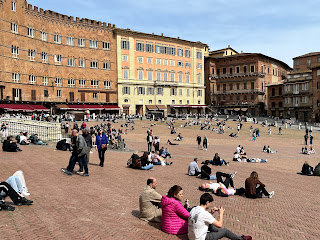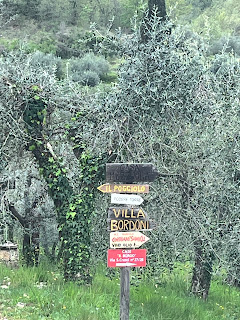Each day should begin with a hug, a kiss, a caress, and a coffee. So said the front of our breakfast menu in Florence during our recent trip to Tuscany. This sage advice seems to work well for the Italians and we strongly endorse it.
We found the people to be warm and friendly, with a sense of
humor and a carefree willingness to modify and adapt. Perhaps drinking copious
amounts of wine contributes to those traits, or perhaps our drinking copious
amounts of wine made us perceive these characteristics in the Italians we
encountered. Either way, we got along famously in this beautiful, romantic
country and we’re already dreaming of going back.
Highlights:

Spectacular untouched landscapes of rolling hills, centuries-old villas surrounded by vineyards, olive trees, and statuesque cypress and cork oak trees.
Medieval (and earlier) villages that remain largely unchanged today, with tall stone bell- and watchtowers, magnificent marble churches whose interiors hold priceless paintings, statues, frescoes, and tapestries, and broad piazzas with narrow roads and canyon-like alleyways that meander outward (and usually downward) to the village’s edges — the same roads that in many cases have been trod for a millennium.
And of course, the magnificent food and wine — antipasto, pasta, hearty meat, and delicious desserts, and luscious brunellos, barolos, and chiantis prepared, poured and consumed seemingly without pause.
Below are impressions of the various locations Donna and I
visited over eight days.
We stayed at the outstanding Palazzo Montebello hotel, an oasis a mile from the heart of the historic city tucked in a quiet handsome neighborhood. The staff was friendly and helpful; our concierge recommended restaurants (Natalino’s, Garga, and Gamberini) that were non-touristy, with outstanding food and gracious, friendly service.
 Florence’s many jaw-droppingly beautiful piazzas and streets wide and narrow were packed with fellow tourists, it being the week before Easter and families from all over the world taking advantage of spring break. In addition, the weather was unseasonably warm and sunny, perfect for families who live nearby to join the out-of-towners. On a couple occasions we could barely move more than the dozens of marble statues populating the various broad squares.
Florence’s many jaw-droppingly beautiful piazzas and streets wide and narrow were packed with fellow tourists, it being the week before Easter and families from all over the world taking advantage of spring break. In addition, the weather was unseasonably warm and sunny, perfect for families who live nearby to join the out-of-towners. On a couple occasions we could barely move more than the dozens of marble statues populating the various broad squares.
Speaking of statues, Donna had arranged for a tour of the museum that houses Michelangelo’s iconic statue of David as well as the Santa Maria del Fiore cathedral and the cathedral’s famous dome.
David is located in the Galleria dell’Accademia, a block north of the cathedral in a room specially designed to house the 17-foot-tall statue of the shepherd boy who, according to the Bible, slayed the giant, fearsome Goliath. Michelangelo’s depiction of David with a muscular physique and mature body is a departure from earlier renderings, as is the time of the depiction – before the battle rather than after David killed and beheaded Goliath. David’s face and body position convey a sense of confidence in the outcome because he believed he had the true God on his side. The statue is remarkable for its detail in the muscles, tendons, and blood vessels Michelangelo chiseled, as well as the expressiveness of David’s face — and the fact that the sculptor was only 26 when he created this masterpiece.
Due to time constraints resulting from the crowds of people all wanting to see the same sights, our tour group couldn’t get us into the cathedral, but we did get to climb to the top of the church’s 600-year-old dome, or cupula. We also visited the incredible Ufizzi museum on the Palazzo Vecchio. The horseshoe-shaped Ufizzi houses the world’s greatest collection of Renaissance paintings, the most famous of which is Botticelli’s The Birth of Venus.
We also visited the incredible Ufizzi museum on the Palazzo Vecchio. The horseshoe-shaped Ufizzi houses the world’s greatest collection of Renaissance paintings, the most famous of which is Botticelli’s The Birth of Venus.


SIENA is another beautiful, ancient town, and a UNESCO World Heritage site. Its duomo piazza is anchored by the magnificent Opera Duomo Siena, which opened in 1215, and the Hospital Santa Maria della Scala built no later than 1090.

Another, larger piazza, Piazza del Campo, is the site of horse races known as the Palio di Siena, which have been held annually since the 1500s.



 We splurged on a seven-course chef’s tasting dinner (with wine pairings from the vineyard) at a Michelin-starred restaurant on-site that defies description. And we learned much about Italian wines during a private wine-tasting event with a very knowledgeable, engaging host. The resort even has a glass museum that was more interesting than I expected.
We splurged on a seven-course chef’s tasting dinner (with wine pairings from the vineyard) at a Michelin-starred restaurant on-site that defies description. And we learned much about Italian wines during a private wine-tasting event with a very knowledgeable, engaging host. The resort even has a glass museum that was more interesting than I expected.
After two nights at Banfi (not nearly enough!), we headed back north to our final hotel.
GREVE IN CHIANTI is the location of Villa Bordoni a rustic,
converted farmhouse with 14 guest rooms, and, like Banfi, is about 1,000 years
old. We planned to use the inn as a base from which to visit medieval towns,
and that we did. But the casual, comfortable vibe and the engaging, warm staff
made us want to spend more time there. We participated in a cooking class that
was great fun. Under the guidance of the delightful Chef Maria we made focaccia,
pasta, tomato sauce, veal stew, and tiramisu, then the group of six students feasted on our creations, drank down the villa’s store of wine, and made friendships.
a rustic,
converted farmhouse with 14 guest rooms, and, like Banfi, is about 1,000 years
old. We planned to use the inn as a base from which to visit medieval towns,
and that we did. But the casual, comfortable vibe and the engaging, warm staff
made us want to spend more time there. We participated in a cooking class that
was great fun. Under the guidance of the delightful Chef Maria we made focaccia,
pasta, tomato sauce, veal stew, and tiramisu, then the group of six students feasted on our creations, drank down the villa’s store of wine, and made friendships.

 We made our final daytrip to Lucca, a good 90-minute drive from Bordoni, and by this time we had tired of visiting churches and museums – we just wanted to wander around and take in what was in front of us. Ancient Lucca is encircled by a tall wall topped with a handsome treelined walkway wide enough for pedestrians, cyclists, and foot-pedaled buggies. We walked along it for a while, then dismounted and strolled along the beautiful streets. As we had done in most other towns, we found a lovely café, ate wonderful food, and recounted our incredible experiences.
We made our final daytrip to Lucca, a good 90-minute drive from Bordoni, and by this time we had tired of visiting churches and museums – we just wanted to wander around and take in what was in front of us. Ancient Lucca is encircled by a tall wall topped with a handsome treelined walkway wide enough for pedestrians, cyclists, and foot-pedaled buggies. We walked along it for a while, then dismounted and strolled along the beautiful streets. As we had done in most other towns, we found a lovely café, ate wonderful food, and recounted our incredible experiences.
 We had an unforgettable, amazing experience in Italy, and it made us want to return as soon as possible.
We had an unforgettable, amazing experience in Italy, and it made us want to return as soon as possible.
Saluti!
Here are more pictures of our trip:
Florence
Siena
Banfi










































Comments
Post a Comment